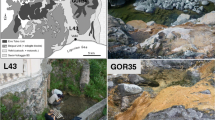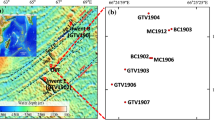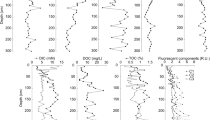Abstract
Anaerobic oxidation of methane (AOM) impacts carbon cycling by acting as a methane sink and by sequestering inorganic carbon via AOM-induced carbonate precipitation. These precipitates commonly take the form of carbonate nodules that form within methane seep sediments. The timing and sequence of nodule formation within methane seep sediments are not well understood. Further, the microbial diversity associated with sediment-hosted nodules has not been well characterized and the degree to which nodules reflect the microbial assemblage in surrounding sediments is unknown. Here, we conducted a comparative study of microbial assemblages in methane-derived authigenic carbonate nodules and their host sediments using molecular, mineralogical, and geochemical methods. Analysis of 16S rRNA gene diversity from paired carbonate nodules and sediments revealed that both sample types contained methanotrophic archaea (ANME-1 and ANME-2) and syntrophic sulfate-reducing bacteria (Desulfobacteraceae and Desulfobulbaceae), as well as other microbial community members. The combination of geochemical and molecular data from Eel River Basin and Hydrate Ridge suggested that some nodules formed in situ and captured the local sediment-hosted microbial community, while other nodules may have been translocated or may represent a record of conditions prior to the contemporary environment. Taken together, this comparative analysis offers clues to the formation regimes and mechanisms of sediment-hosted carbonate nodules.





Similar content being viewed by others
References
Hoehler TM, Alperin MJ, Albert DB, Martens CS (1994) Field and laboratory studies of methane oxidation in an anoxic marine sediment: evidence for a methanogen-sulfate reducer consortium. Glob Biogeochem Cycles 8:451. doi:10.1029/94GB01800
Boetius A, Ravenschlag K, Schubert CJ et al (2000) A marine microbial consortium apparently mediating anaerobic oxidation of methane. Nature 407:623–626. doi:10.1038/35036572
Reeburgh WS (2007) Oceanic methane biogeochemistry. Chem Rev 107:486–513. doi:10.1021/cr050362v
Luff R, Wallmann K (2003) Fluid flow, methane fluxes, carbonate precipitation and biogeochemical turnover in gas hydrate-bearing sediments at hydrate ridge, Cascadia margin: numerical modeling and mass balances. Geochim Cosmochim Acta 67:3403–3421. doi:10.1016/S0016-7037(03)00127-3
Lein A (2004) Authigenic carbonate formation in the ocean. Lithol Miner Resour 39:1–30
Luff R, Wallmann K, Aloisi G (2004) Numerical modeling of carbonate crust formation at cold vent sites: significance for fluid and methane budgets and chemosynthetic biological communities. Earth Planet Sci Lett 221:337–353. doi:10.1016/S0012-821X(04)00107-4
Jørgensen NO (1989) Holocene methane-derived, dolomite-cemented sandstone pillars from the Kattegat, Denmark. Mar Geol 88:71–81. doi:10.1016/0025-3227(89)90005-4
Jørgensen NO (1992) Methane-derived carbonate cementation of marine sediments from the Kattegat, Denmark: geochemical and geological evidence. Mar Geol 103:1–13. doi:10.1016/0025-3227(92)90006-4
Hovland M, Talbot MR, Qvale H et al (1987) Methane-related carbonate cements in pockmarks of the North Sea. J Sediment Res 57:881–892
Chen Z, Yan W, Chen M et al (2006) Discovery of seep carbonate nodules as new evidence for gas venting on the northern continental slope of South China Sea. Chin Sci Bull 51:1228–1237. doi:10.1007/s11434-006-1228-8
Ussler W III, Paull CK (2008) Rates of anaerobic oxidation of methane and authigenic carbonate mineralization in methane-rich deep-sea sediments inferred from models and geochemical profiles. Earth Planet Sci Lett 266:271–287. doi:10.1016/j.epsl.2007.10.056
Watanabe Y, Nakai S, Hiruta A et al (2008) U–Th dating of carbonate nodules from methane seeps off Joetsu, Eastern Margin of Japan Sea. Earth Planet Sci Lett 272:89–96. doi:10.1016/j.epsl.2008.04.012
Griffiths RP, Caldwell BA, Cline JD et al (1982) Field observations of methane concentrations and oxidation rates in the Southeastern Bering Sea. Appl Environ Microbiol 44:435–446
Gulin SB, Polikarpov GG, Egorov VN (2003) The age of microbial carbonate structures grown at methane seeps in the Black Sea with an implication of dating of the seeping methane. Mar Chem 84:67–72. doi:10.1016/S0304-4203(03)00103-8
Teichert B, Bohrmann G, Suess E (2005) Chemoherms on Hydrate Ridge—unique microbially-mediated carbonate build-ups growing into the water column. Palaeo 227:67–85. doi:10.1016/j.palaeo.2005.04.029
Michaelis W, Seifert R, Nauhaus K et al (2002) Microbial reefs in the Black Sea fueled by anaerobic oxidation of methane. Science 297:1013–1015. doi:10.1126/science.1072502
Boetius A, Suess E (2004) Hydrate Ridge: a natural laboratory for the study of microbial life fueled by methane from near-surface gas hydrates. Chem Geol 205:291–310. doi:10.1016/j.chemgeo.2003.12.034
Paull CK, Chanton JP, Neumann AC et al (1992) Indicators of methane-derived carbonates and chemosynthetic organic carbon deposits: examples from the Florida escarpment. Palaios 7:361. doi:10.2307/3514822
Greinert J, Bohrmann G, Suess E (2001) Gas hydrate‐associated carbonates and methane‐venting at hydrate ridge: classification, distribution, and origin of authigenic lithologies. In: Paull CK, Dillon WP (eds) Natural gas hydrates. American Geophysical Union, Washington, D. C., pp 99–113
Gieskes J, Mahn C, Day S et al (2005) A study of the chemistry of pore fluids and authigenic carbonates in methane seep environments: Kodiak Trench, Hydrate Ridge, Monterey Bay, and Eel River Basin. Chem Geol 220:329–345
Naehr TH, Eichhubl P, Orphan VJ et al (2007) Authigenic carbonate formation at hydrocarbon seeps in continental margin sediments: a comparative study. Deep Sea Res Part II 54:1268–1291. doi:10.1016/j.dsr2.2007.04.010
Haas A, Peckmann J, Elvert M et al (2010) Patterns of carbonate authigenesis at the Kouilou pockmarks on the Congo deep-sea fan. Mar Geol 268:129–136. doi:10.1016/j.margeo.2009.10.027
Naehr TH, Birgel D, Bohrmann G et al (2009) Biogeochemical controls on authigenic carbonate formation at the Chapopote “asphalt volcano”, Bay of Campeche. Chem Geol 266:390–402. doi:10.1016/j.chemgeo.2009.07.002
Peckmann J, Thiel V (2004) Carbon cycling at ancient methane-seeps. Chem Geol 205:443–467
Marlow JJ, Steele JA, Ziebis W et al (2014) Carbonate-hosted methanotrophy represents an unrecognized methane sink in the deep sea. Nat Commun 5:5094. doi:10.1038/ncomms6094
Peckmann J, Thiel V, Michaelis W et al (1999) Cold seep deposits of Beauvoisin (Oxfordian; southeastern France) and Marmorito (Miocene; northern Italy): microbially induced authigenic carbonates. Int J Earth Sci (Geol Rundsch) 88:60–75. doi:10.1007/s005310050246
Stadnitskaia A, Muyzer G, Abbas B et al (2005) Biomarker and 16S rDNA evidence for anaerobic oxidation of methane and related carbonate precipitation in deep-sea mud volcanoes of the Sorokin Trough, Black Sea. Mar Geol 217:67–96. doi:10.1016/j.margeo.2005.02.023
Stadnitskaia A, Nadezhkin D, Abbas B et al (2008) Carbonate formation by anaerobic oxidation of methane: evidence from lipid biomarker and fossil 16S rDNA. Geochim Cosmochim Acta 72:1824–1836. doi:10.1016/j.gca.2008.01.020
Thiel V, Peckmann J, Richnow HH et al (2001) Molecular signals for anaerobic methane oxidation in Black Sea seep carbonates and a microbial mat. Mar Chem 73:97–112
Birgel D, Elvert M, Han X, Peckmann J (2008) 13C-depleted biphytanic diacids as tracers of past anaerobic oxidation of methane. Org Geochem 39:152–156. doi:10.1016/j.orggeochem.2007.08.013
Birgel D, Himmler T, Freiwald A, Peckmann J (2008) A new constraint on the antiquity of anaerobic oxidation of methane: Late Pennsylvanian seep limestones from southern Namibia. Geology 36:543–546. doi:10.1130/G24690A.1
Aloisi G, Bouloubassi I, Heijs SK et al (2002) CH4-consuming microorganisms and the formation of carbonate crusts at cold seeps. Earth Planet Sci Lett 203:195–203. doi:10.1016/S0012-821X(02)00878-6
Heijs SK, Aloisi G, Bouloubassi I et al (2006) Microbial community structure in three deep-sea carbonate crusts. Microb Ecol 52:451–462. doi:10.1007/s00248-006-9099-8
Guan H, Sun Y, Zhu X et al (2013) Factors controlling the types of microbial consortia in cold-seep environments: a molecular and isotopic investigation of authigenic carbonates from the South China Sea. Chem Geol 354:55–64. doi:10.1016/j.chemgeo.2013.06.016
Marlow JJ, Steele JA, Case DH et al (2014) Microbial abundance and diversity patterns associated with sediments and carbonates from the methane seep environments of Hydrate Ridge, OR. Front Mar Sci. doi:10.3389/fmars.2014.00044
Bayon G, Dupré S, Ponzevera E et al (2013) Formation of carbonate chimneys in the Mediterranean Sea linked to deep-water oxygen depletion. Nat Geosci 6:1–6. doi:10.1038/ngeo1888
Teichert B, Eisenhauer A, Bohrmann G et al (2003) U/Th systematics and ages of authigenic carbonates from Hydrate Ridge, Cascadia Margin: recorders of fluid flow variations. Geochim Cosmochim Acta 67:3845–3857
Kutterolf S, Liebetrau V, Mörz T et al (2008) Lifetime and cyclicity of fluid venting at forearc mound structures determined by tephrostratigraphy and radiometric dating of authigenic carbonates. Geology 36:707–710. doi:10.1130/G24806A.1
Liebetrau V, Eisenhauer A, Linke P (2010) Cold seep carbonates and associated cold-water corals at the Hikurangi Margin, New Zealand: new insights into fluid pathways, growth structures and geochronology. Mar Geol 272:307–318. doi:10.1016/j.margeo.2010.01.003
Orphan V, Ussler W, Naehr TH et al (2004) Geological, geochemical, and microbiological heterogeneity of the seafloor around methane vents in the Eel River Basin, offshore California. Chem Geol 205:265–289. doi:10.1016/j.chemgeo.2003.12.035
Torres M, McManus J, Hammond D et al (2002) Fluid and chemical fluxes in and out of sediments hosting methane hydrate deposits on Hydrate Ridge, OR, I: hydrological provinces. Earth Planet Sci Lett 201:525–540
Treude T, Boetius A, Knittel K et al (2003) Anaerobic oxidation of methane above gas hydrates at Hydrate Ridge, NE Pacific Ocean. Mar Ecol Prog Ser 264:1–14
Sahling H, Rickert D, Lee RW, et al (2002) Macrofaunal community structure and sulfide flux at gas hydrate deposits from the Cascadia convergent margin, NE Pacific. Marine Ecology Progress Series
Levin LA (2005) Ecology of cold seep sediments: interactions of fauna with flow, chemistry, and microbes. Oceanogr Mar Biol Annu Rev 43:1–46
Barry JP, Kochevar RE, Baxter CH (1997) The influence of pore-water chemistry and physiology on the distribution of vesicomyid clams at cold seeps in Monterey Bay: implications for patterns of chemosynthetic community organization. Limnol Oceanogr 42:318–328
Fischer D, Sahling H, Nöthen K et al (2012) Interaction between hydrocarbon seepage, chemosynthetic communities, and bottom water redox at cold seeps of the Makran accretionary prism: insights from habitat-specific pore water sampling and modeling. Biogeosciences 9:2013–2031. doi:10.5194/bg-9-2013-2012
Lloyd KG, Albert DB, Biddle JF et al (2010) Spatial structure and activity of sedimentary microbial communities underlying a Beggiatoa spp. Mat in a Gulf of Mexico hydrocarbon seep. PLoS ONE 5:e8738. doi:10.1371/journal.pone.0008738
Pernthaler A, Dekas AE, Brown CT et al (2008) Diverse syntrophic partnerships from deep-sea methane vents revealed by direct cell capture and metagenomics. Proc Natl Acad Sci 105:7052–7057. doi:10.1073/pnas.0711303105
Green-Saxena A, Dekas AE, Dalleska NF, Orphan VJ (2014) Nitrate-based niche differentiation by distinct sulfate-reducing bacteria involved in the anaerobic oxidation of methane. ISME J 8:150–163. doi:10.1038/ismej.2013.147
Suess E, Torres ME, Bohrmann G et al (2001) Sea floor methane hydrates at hydrate ridge, Cascadia margin. In: Paull CK, Dillon WP (eds) Natural gas hydrates. American Geophysical Union, Washington, D. C., pp 87–98
Bohrmann G, Greinert J, Suess E, Torres M (1998) Authigenic carbonates from the Cascadia subduction zone and their relation to gas hydrate stability. Geology 26:647. doi:10.1130/0091-7613(1998)026<0647:ACFTCS>2.3.CO;2
Orphan VJ, Hinrichs KU, Ussler W et al (2001) Comparative analysis of methane-oxidizing archaea and sulfate-reducing bacteria in anoxic marine sediments. Appl Environ Microbiol 67:1922–1934. doi:10.1128/AEM.67.4.1922-1934.2001
Naehr TH, Rodriguez NM, Bohrmann G, et al (2000) Methane-derived authigenic carbonates associated with gas hydrate decomposition and fluid venting above the Blake Ridge Diapir
Goffredi SK, Wilpiszeski R, Lee R, Orphan VJ (2008) Temporal evolution of methane cycling and phylogenetic diversity of archaea in sediments from a deep-sea whale-fall in Monterey Canyon, California. ISME J 2:204–220. doi:10.1038/ismej.2007.103
Barry JP, Gary Greene H, Orange DL et al (1996) Biologic and geologic characteristics of cold seeps in Monterey Bay, California. Deep-Sea Res I Oceanogr Res Pap 43:1739–1762. doi:10.1016/S0967-0637(96)00075-1
Gieskes JM, Gamo T, Brumsack H (1991) Chemical methods for interstitial water analysis aboard JOIDES Resolution. Ocean Drilling Program Texas A&M University
Gilbert JA, Meyer F, Jansson J, et al (2011) The Earth Microbiome Project: meeting report of the “1st EMP meeting on sample selection and acquisition” at Argonne National Laboratory October 6th 2010. 1–5. doi:10.4056/sigs.1443528
Caporaso JG, Lauber CL, Walters WA et al (2011) Global patterns of 16S rRNA diversity at a depth of millions of sequences per sample. Proc Natl Acad Sci 108:4516–4522. doi:10.1073/pnas.1000080107/-/DCSupplemental
Caporaso JG, Lauber CL, Walters WA et al (2012) Ultra-high-throughput microbial community analysis on the Illumina HiSeq and MiSeq platforms. ISME J 6:1621–1624. doi:10.1038/ismej.2012.8
Berry D, Ben Mahfoudh K, Wagner M, Loy A (2011) Barcoded primers used in multiplex amplicon pyrosequencing bias amplification. Appl Environ Microbiol 77:7846–7849. doi:10.1128/AEM.05220-11
Caporaso JG, Kuczynski J, Stombaugh J et al (2010) QIIME allows analysis of high-throughput community sequencing data. Nat Methods 7:335–336. doi:10.1038/nmeth.f.303
Aronesty E (2011) ea-utils: command-line tools for processing biological sequencing data
Edgar RC, Haas BJ, Clemente JC et al (2011) UCHIME improves sensitivity and speed of chimera detection. Bioinformatics 27:2194–2200. doi:10.1093/bioinformatics/btr381
Edgar RC (2010) Search and clustering orders of magnitude faster than BLAST. Bioinformatics 26:2460–2461. doi:10.1093/bioinformatics/btq461
Wang Q, Garrity GM, Tiedje JM, Cole JR (2007) Naïve Bayesian classifier for rapid assignment of rRNA sequences into the new bacterial taxonomy. Appl Environ Microbiol 73:5261–5267. doi:10.1128/AEM.00062-07
Quast C, Pruesse E, Yilmaz P, et al (2012) The SILVA ribosomal RNA gene database project: improved data processing and web-based tools. Nucl Acids Res gks1219. doi:10.1093/nar/gks1219
Salter S, Cox M, Turek E et al (2014) Reagent and laboratory contamination can critically impact sequence-based microbiome analyses. BMC Biol 12:1–12. doi:10.1186/s12915-014-0087-z
Clarke KR, Warwick RM (2001) Change in marine communities, 2nd edn. PRIMER-E Ltd, Plymouth
McCune B, Grace JB, Urban DL (2002) Analysis of ecological communities. MjM Software Design, Gleneden Beach
Ludwig W, Strunk O, Westram R et al (2004) ARB: a software environment for sequence data. Nucl Acids Res 32:1363–1371. doi:10.1093/nar/gkh293
Nunoura T, Takaki Y, Kazama H et al (2012) Microbial diversity in deep-sea methane seep sediments presented by SSU rRNA gene tag sequencing. Microbiol Environ 27:382–390. doi:10.1264/jsme2.ME12032
Takai K, Horikoshi K (1999) Genetic diversity of archaea in deep-sea hydrothermal vent environments. Genetics 152:1285–1297
Teske A, Sorensen KB (2008) Uncultured archaea in deep marine subsurface sediments: have we caught them all? ISME J 2:3–18. doi:10.1038/ismej.2007.90
Knittel K, Lösekann T, Boetius A et al (2005) Diversity and distribution of methanotrophic archaea at cold seeps. Appl Environ Microbiol 71:467–479. doi:10.1128/AEM.71.1.467-479.2005
Heijs SK, Sinninghe Damsté JS, Forney LJ (2005) Characterization of a deep‐sea microbial mat from an active cold seep at the Milano mud volcano in the Eastern Mediterranean Sea. FEMS Microbiol Ecol 54:47–56. doi:10.1016/j.femsec.2005.02.007
Kendall MM, Wardlaw GD, Tang CF et al (2007) Diversity of archaea in marine sediments from Skan Bay, Alaska, including cultivated methanogens, and description of Methanogenium boonei sp. nov. Appl Environ Microbiol 73:407–414. doi:10.1128/AEM.01154-06
Roalkvam I, Jørgensen SL, Chen Y et al (2011) New insight into stratification of anaerobic methanotrophs in cold seep sediments. FEMS Microbiol Ecol 78:233–243. doi:10.1111/j.1574-6941.2011.01153.x
Niemann H, Linke P, Knittel K et al (2013) Methane-carbon flow into the benthic food web at cold seeps—a case study from the Costa Rica Subduction Zone. PLoS ONE 8:e74894. doi:10.1371/journal.pone.0074894
Inagaki F, Takai K, Nealson KH, Horikoshi K (2004) Sulfurovum lithotrophicum gen. nov., sp. nov., a novel sulfur-oxidizing chemolithoautotroph within the ε-Proteobacteria isolated from Okinawa Trough hydrothermal sediments. Int J Syst Evol Microbiol 54:1477–1482. doi:10.1099/ijs.0.03042-0
Kodama Y, Watanabe K (2003) Isolation and characterization of a sulfur-oxidizing chemolithotroph growing on crude oil under anaerobic conditions. Appl Environ Microbiol 69:107–112. doi:10.1128/AEM.69.1.107-112.2003
Inagaki F, Takai K, Kobayashi H et al (2003) Sulfurimonas autotrophica gen. nov., sp. nov., a novel sulfur-oxidizing ε-proteobacterium isolated from hydrothermal sediments in the Mid-Okinawa Trough. Int J Syst Evol Microbiol 53:1801–1805. doi:10.1099/ijs.0.02682-0
Suess E, Torres ME, Bohrmann G et al (1999) Gas hydrate destabilization: enhanced dewatering, benthic material turnover and large methane plumes at the Cascadia convergent margin. Earth Planet Sci Lett 170:1–15. doi:10.1016/S0012-821X(99)00092-8
Orphan VJ, House CH, Hinrichs KU et al (2001) Methane-consuming archaea revealed by directly coupled isotopic and phylogenetic analysis. Science 293:484–487
Thurber AR, Levin LA, Orphan VJ, Marlow JJ (2012) Archaea in metazoan diets: implications for food webs and biogeochemical cycling. ISME J 6:1606–1612
Krause S, Liebetrau V, Gorb S et al (2012) Microbial nucleation of Mg-rich dolomite in exopolymeric substances under anoxic modern seawater salinity: new insight into an old enigma. Geology 40:587–590. doi:10.1130/G32923.1
Vasconcelos C, Mckenzie JA, Bernasconi S et al (1995) Microbial mediation as a possible mechanism for natural dolomite formation at low temperatures. Nature 377:220–222
Vasconcelos C, Mckenzie JA, Warthmann R, Bernasconi SM (2005) Calibration of the δ18O paleothermometer for dolomite precipitated in microbial cultures and natural environments. Geology 33:317–320
Ijiri A, Tsunogai U, Gamo T et al (2009) Enrichment of adsorbed methane in authigenic carbonate concretions of the Japan Trench. Geo-Mar Lett 29:301–308. doi:10.1007/s00367-009-0143-9
Peckmann J, Reimer A, Luth C et al (2001) Methane-derived carbonates and authigenic pyrite from the northwestern Black Sea. Mar Geol 177:129–150. doi:10.1016/S0025-3227(01)00128-1
Campbell KA, Nelson CS, Alfaro AC et al (2010) Geological imprint of methane seepage on the seabed and biota of the convergent Hikurangi Margin, New Zealand: box core and grab carbonate results. Mar Geol 272:285–306. doi:10.1016/j.margeo.2010.01.002
Bailey JV, Raub TD, Meckler AN et al (2010) Pseudofossils in relict methane seep carbonates resemble endemic microbial consortia. Palaeogeogr Palaeoclimatol Palaeoecol 285:131–142. doi:10.1016/j.palaeo.2009.11.002
Acknowledgments
VO conceived of the study and collected the samples at sea. OM processed the samples and optimized DNA extraction, as well as TRFLP and clone library analyses. DC performed iTAG processing and analyses, beta diversity analyses, and was the coordinating author of the manuscript. TN provided XRD data, RL performed the isotopic composition analyses, JB provided thin section images, and RT performed the pore water geochemical measurements. DC, OM, and VO principally contributed to writing the manuscript. Three anonymous reviews provided constructive suggestions to improve the manuscript. Elizabeth Trembath-Reichert, Stephanie Connon, and Jeff Marlow helped with customization of the Silva115_NR99 database. Alexis Pasulka provided helpful discussion regarding ordination and statistical probing of microbial communities. Josh Steele also provided discussion on ecological statistics and aided with bench-top lab work. Benjamin Harrison helped with TRFLP data interpretation. Jeff Marlow provided useful feedback on the manuscript. The crew of the R/V Atlantis cruise AT-15-11, as well as the pilots of DSV Alvin dives AD4249 and 4256, aided in sample recovery at sea. Funding for this work was provided by a National Science Foundation grant (BIO-OCE 0825791) to VO and an early career grant by the United States Department of Energy, Office of Biological and Environmental Research (DE-SC0003940) to VO. This research was also supported by a grant from the NASA Astrobiology Institute (Award #NNA13AA92A) to VO. This is NAI-Life Underground Publication 009. DC was funded by a National Science Foundation Graduate Research Fellowship.
Author information
Authors and Affiliations
Corresponding authors
Additional information
Olivia U. Mason and David H. Case share co-first authorship.
Rights and permissions
About this article
Cite this article
Mason, O.U., Case, D.H., Naehr, T.H. et al. Comparison of Archaeal and Bacterial Diversity in Methane Seep Carbonate Nodules and Host Sediments, Eel River Basin and Hydrate Ridge, USA. Microb Ecol 70, 766–784 (2015). https://doi.org/10.1007/s00248-015-0615-6
Received:
Accepted:
Published:
Issue Date:
DOI: https://doi.org/10.1007/s00248-015-0615-6




